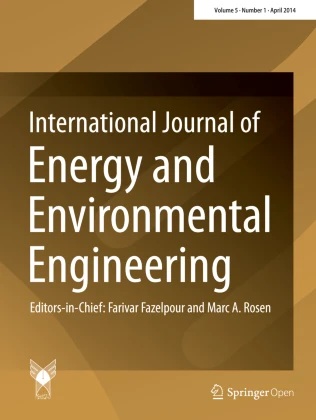Potentials of sustainable electricity production from sawdust by small-scale wood transformation units: a case study in Cameroon
- Department of Environmental Engineering, National Advanced School of Public Works, Yaounde, CM Department of Civil, Environmental and Architectural Engineering, University of Padua, Padova, 35131, IT
- Department of Nutrition, Food and Bio-Resource Technology, College of Technology, University of Bamenda, Bamenda, CM
- Department of Biological and Agricultural Engineering, LSU AgCenter, Baton Rouge, LA, US
- Department of Environmental Engineering, National Advanced School of Public Works, Yaounde, CM

Published in Issue 2020-10-20
How to Cite
Veeyee, K. F., Bup, N. D., Boldor, D., & Elambo, N. G. (2020). Potentials of sustainable electricity production from sawdust by small-scale wood transformation units: a case study in Cameroon. International Journal of Energy and Environmental Engineering, 12(1 (March 2021). https://doi.org/10.1007/s40095-020-00362-0
Abstract
Abstract Wood processing produces large volumes of residues which, when not properly managed, pose an environmental problem in the vicinity and beyond. These residues mainly constituted of sawdust and wood shavings, possess important energy potentials that are largely underexploited in Cameroon. In this work, we investigate the possibility that sawdust generated by wood transformation units (WTU) in Cameroon can be used sustainably to render them self-sufficient in terms of electricity demands through the production of syngas in a gasification process. Both qualitative and quantitative methods are used in the research. Initially, a questionnaire was employed to quantify the sawdust produced in the town of Yaounde, Cameroon. A major WTU “LFM_Sciérie” was selected to evaluate the feasibility of electricity generation from syngas produced by gasification of its wood waste. Proximate analysis of sawdust sampled from the LFM sawmill included moisture content 17.74 ± 0.27%, ash content 3.91 ± 1.54%, volatile matter 74.62 ± 1.47%, and fixed carbon 3.73%. The gross calorific value of the sawdust sample was estimated to be 20.08 MJ/kg. The total quantity of sawdust produced in the Yaounde municipalities is 290 tons/week which translates to an energy potential of 713 GJ/week. Theoretical calculations and modelling using a thermodynamics software, Cycle-Tempo, indicate that the amount of sawdust generated at the LFM sawmill of about 7 tons/week, can conveniently satisfy its electricity demands of approximately 3.3 MW/week. Small-scale WTUs in Yaounde can be rendered energy-autonomous by the generation of electricity from syngas produced via a gasification process of its waste.Keywords
- Syngas,
- Sawdust,
- Energy production,
- Wood transformation,
- Cameroon
References
- Mboumboue and Njomo (2018) Biomass resources assessment and bioenergy generation for a clean and sustainable development in Cameroon https://doi.org/10.1016/j.biombioe.2018.08.002
- Muh et al. (2018) Sustainable energy policies in Cameroon: a holistic overview https://doi.org/10.1016/j.rser.2017.10.049
- Grijsen, J.: Understanding the impact of climate change on hydropower: the case of Cameroon, 2014
- Ackom et al. (2013) Modern bioenergy from agricultural and forestry residues in Cameroon: potential, challenges and the way forward https://doi.org/10.1016/j.enpol.2013.09.006
- Vinterbäck, J., Ladanai, S.: Certification criteria for sustainable biomass for energy, Uppsala, 2010.
- Perea-Moreno et al. (2019) Biomass as renewable energy: worldwide research trends https://doi.org/10.3390/su11030863
- Brosowski (2016) A review of biomass potential and current utilisation—Status quo for 93 biogenic wastes and residues in Germany https://doi.org/10.1016/j.biombioe.2016.10.017
- Mussatto and Dragone (2016) (pp. 1-22) Elsevier
- Effanga and Development (2010) Swedish University of agricultural Sciences (SLU)
- González-garcía and Bacenetti (2019) Science of the total environment exploring the production of bio-energy from wood biomass https://doi.org/10.1016/j.scitotenv.2018.07.295
- Abanda (2012) Renewable energy sources in Cameroon: Potentials, benefits and enabling environment (pp. 4557-4562) https://doi.org/10.1016/j.rser.2012.04.011
- FAO: State of the World’s Forests. 2011
- Nzotcha and Kenfack (2019) Contribution of the wood-processing industry for sustainable power generation: Viability of biomass-fuelled cogeneration in Sub-Saharan https://doi.org/10.1016/j.biombioe.2018.11.015
- OECD/IEA: Sustainable production of second-generation biofuels potential and perspectives in major economies and developing countries, Paris, France, 2010
- Okedere et al. (2017) Particulate matter pollution from open burning of sawdust in Southwestern Nigeria https://doi.org/10.1080/23311843.2017.1367112
- Simo and Siyam Siwe (2000) Availability and conversion to energy potentials of wood-based industry residues in Cameroon https://doi.org/10.1016/S0960-1481(99)00033-6
- FAO: FORESTRY Key issues. 2008
- Kurchania et al. (2012) (pp. 91-122) Springer https://doi.org/10.1007/978-3-642-28418-2_2
- Freiberg et al. (2018) The use of biomass for electricity generation: a scoping review of health effects on humans in residential and occupational settings https://doi.org/10.3390/ijerph15020354
- Owoyemi et al. (2016) Sustainable wood waste management in Nigeria (pp. 1-9) https://doi.org/10.1515/environ-2016-0012
- Djouedjom Talla et al. (2018) Current status of renewable energy in Cameroon
- Asibor et al. (2019) Energy potential study of some tropical wood species from Nigeria (pp. 1-10) https://doi.org/10.9734/cjast/2019/v37i430295
- Dahlquist (2013) CRC Press https://doi.org/10.1201/b14561
- Cerutti, P.O., Mbongo, M., Vandenhaute, M.: State of the timber sector in Cameroon, Indonesia, 2015
- Unknown (2018) ASIMPTOTE
- Cai, J.
- et al.
- : Review of physicochemical properties and analytical characterization of lignocellulosic biomass. Renew. Sustain. Energy Rev., pp. 1–50, 2017. Available:
- https://creativecommons.org/licenses/by-nc-nd/4.0/%0AReview
- Waldheim, L.: Heating value of gases from biomass gasification report prepared for: IEA Bioenergy Agreement, Task 20—Thermal Gasification of Biomass, no. May, p. 60, 2001
- Rajvanshi (2014) Biomass gasification (pp. 1-21)
- Sanke and Reddy (2008) Biomass for energy generation (pp. 397-401) https://doi.org/10.24084/repqj06.309
- Nzali et al. (2019) Effect of particle size on syngas production using sawdust of Cameroonian Triplochiton scleroxylon https://doi.org/10.1016/j.sciaf.2019.e00182
- Jahirul et al. (2012) Biofuels production through biomass pyrolysis—a technological review https://doi.org/10.3390/en5124952
- Wang et al. (2008) Contemporary issues in thermal gasification of biomass and its application to electricity and fuel production https://doi.org/10.1016/j.biombioe.2007.12.007
- Hameed et al. (2018) Al: Studies on characterization of sawdust for application in a gasification process for syngas production (pp. 1022-1026) https://doi.org/10.30684/etj.36.10A.1
- Lazaroiu et al. (2018) Experimental investigations of innovative biomass energy harnessing solutions 11(12) https://doi.org/10.3390/en11123469
- Mihăescu, L., Tudor, P., Manuela Elena, G., Gheorghe, L., Ion, O., Ionel, P., Gabriel Paul, N., Elena, P., Viorel, B. Construction and testing of a 600 KW burner for sawdust in suspension. pp 11–13.

 10.1007/s40095-020-00362-0
10.1007/s40095-020-00362-0











